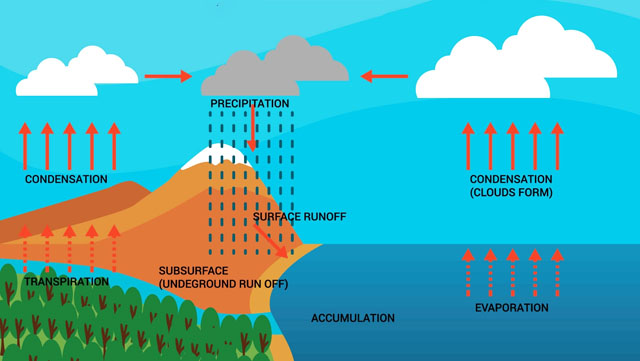The Earths Water Cycle
The amount of water in the earth’s environment never changes, whether it is as a liquid (fresh water, seawater, rain, tiny droplets in clouds), as a gas (water vapour) or in its solid state (snow, ice or hail). There is also water inside living organisms. Water continually circulates between the land, the oceans and the atmosphere. This circulation is called the Water Cycle or Hydrologic Cycle.
How does the Earths water cycle work?
Heat from the sun causes water to become a gas, or vapor. This is called evaporation. As the earth’s surface warms, rising currents of air carry the water vapor upwards. The water vapor becomes cooler as it rises, and condenses into tiny drops, forming clouds. These drops join together and fall back to the earth as rain, hail or snow.
Rainfall may:
- evaporate directly from water, land or vegetation
- run off the land into streams and wetlands
- soak a little way into the ground, be absorbed by plant roots, then return to the water vapor in the air by evaporation from the leaves of plants
- soak deeper into the ground and add to the groundwater, moving slowly along the direction of groundwater flow towards rivers, wetlands or the sea.
This cycle has existed since water was formed on earth. Human activities change the way water moves through the landscape.

Water hasn’t changed ……..
- The water present on earth today is the same water that was present during the time of the dinosaurs.
- In a continuous process called the hydrologic cycle, water evaporates into the atmosphere from lakes, rivers, oceans and plants, forms clouds, and then returns to earth in the form of rain, snow, sleet and hail.
- Because it tends to dissolve small amounts of almost any substance it touches Water is sometimes known as the universal solvent.
- As it falls to earth, it may dissolve impurities it comes in contact with from the air.
- On earth, it may dissolve surface materials, and as it seeps down through layers of rock and soil, it may dissolve additional substances, such as minerals like calcium and iron.
- Man-made substances such as herbicides, insecticides, TCB’s and TCE’s may enter the picture. Besides the many sources of industrial and agricultural pollution, water may also pick up contaminants. Lead, sand, and rust particles may be added in its journey from wells or through municipal and residential distribution systems.
- Over the last 100 years, the earth’s population has nearly tripled. During this time, we have discovered nuclear energy, synthetic chemicals, and cryptosporidium, among other things.
